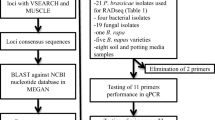Abstract
Random amplified polymorphic DNA (RAPD) analysis using the OPG-06 primer generated specific patterns for Japanese genotypes US-1, JP-1, and a new A1 (JP-2, JP-3, and JP-4) of Phytophthora infestans. N605, a specific RAPD fragment, was cloned and sequenced. PCR primers BD1/BD2 were constructed based on the N605 sequence and were used to clarify the genotypes. PCR products using the BD1/BD2 primers (N605ab marker) easily distinguished the new A1 from US-1 and JP-1. This technique provides a simple and effective method for rapid genotype discrimination that can be used in ecological experiments and forecasts for the occurrence of late blight.


Similar content being viewed by others
References
Akino S, Gotoh K, Nishimura R, Maeda A, Naito S, Ogoshi A (2004) Comparison of Chinese and Japanese A1 isolates of Phytophthora infestans. J Gen Plant Pathol 70:212–214
Akino S, Kato M, Gotoh K, Naito S, Ogoshi A (2005) Genetic relationships between the dominant genotypes of Phytophthora infestans in Hokkaido, Japan. J Gen Plant Pathol 71:200–203
Brasier CM (1992) Evolutionary biology of Phytophthora. Part I genetic system, sexuality and the generation of variation. Ann Rev Phytopathol 30:153–171
Caten CE, Jinks JL (1968) Spontaneous variability of single isolates of Phytophthora infestans. I. Cultural variation. Can J Bot 46:329–348
Goodwin SB, Drenth A (1997) Origin of the A2 mating type of Phytophthora infestans outside Mexico. Phytopathology 87: 992–999
Goodwin SB, Drenth A, Fry WE (1992) Cloning and genetic analyses of two highly polymorphic, moderately repetitive nuclear DNAs from Phytophthora infestans. Curr Genet 22:107–115
Goodwin SB, Schneider RE, Fry WE (1995) Use of cellulose-acetate electrophoresis for rapid identification of allozyme genotypes of Phytophthora infestans. Plant Dis 79:1181–1185
Gotoh K, Akino S, Maeda A, Kondo N, Naito S, Kato M, Ogoshi A (2005) Characterization of some Asian isolates of Phytophthora infestans. Plant Pathol 54:733–739
Gotoh K, Akino S, Kato M, Kondo N, Naito S (2007) New multilocus genotypes of Phytophthora infestans in Japan. J Gen Plant Pathol 73:349–352
Kato M, Naito S (1997) Occurrence and geographical distribution of new strains of the A1 mating type of Phytophthora infestans in Hokkaido. Ann Phytopathol Soc Jpn 63:529 (Abstract in Japanese)
Kato M, Naito S (2001) Change of predominant genotypes of Phytophthora infestans in Tokachi district, Hokkaido, Japan and difference of lesion productivity to the field resistant cultivar ‘Matilda’ among genotypes. J Agric Univ Hebei 24:11–15
Knapova G, Schlenzig A, Gisi U (2002) Crosses between isolates of Phytophthora infestans from potato and tomato and characterization of F1 and F2 progeny for phenotypic and molecular markers. Plant Pathol 51:698–709
Koh YJ, Goodwin SB, Dyer AT, Cohen BA, Ogoshi A, Sato N, Fry WE (1994) Migrations and displacements of Phytophthora infestans populations in east Asian countries. Phytopathology 84:922–927
Lees AK, Wattier R, Shaw DS, Sullivan L, Williams NA, Cooke DEL (2006) Novel microsatellite markers for the analysis of Phytophthora infestans populations. Plant Pathol 55:311–319
Monna L, Miyao A, Inoue T, Fukuoka S, Yamazaki M, Zhong HS, Sasaki T, Minobe Y (1994) Determination of RAPD markers in rice and their conversion into sequence tagged sites (STSs) and STS-specific primers. DNA Res 1:139–148
Mosa AA, Kato M, Sato N, Kobayashi K, Ogoshi A (1989) Occurrence of the A2 mating type of Phytophthora infestans on potato in Japan. Ann Phytopathol Soc Jpn 55:615–620
Author information
Authors and Affiliations
Corresponding author
Rights and permissions
About this article
Cite this article
Akino, S., Shirasawa, Y., Kondo, N. et al. N605ab, a specific molecular marker for Phytophthora infestans, distinguishes three genotypes in Japan. J Gen Plant Pathol 74, 125–127 (2008). https://doi.org/10.1007/s10327-007-0065-1
Received:
Accepted:
Published:
Issue Date:
DOI: https://doi.org/10.1007/s10327-007-0065-1




